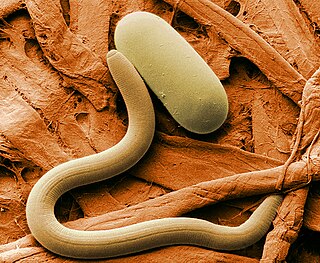
Rhabditida is an order of free-living, zooparasitic, and phytoparasitic microbivorous nematodes living in soil.

The Trichocephalida is an order of parasitic nematodes.

Heterodera is a genus of nematodes in the family Heteroderidae. Members of the genus are obligate parasites and different species attack different crops, often causing great economic damage. The genus is unique among nematode genera because of the ability of the female to transform into a tough, brown, cyst which protects the eggs which have been formed within her body. The name heterodera "refers to the different 'skins' of female and cyst."

The Eupnoi are a suborder of harvestmen, with more than 200 genera, and about 1,700 described species.

The Ascarididae are a family of the large intestinal roundworms. Members of the family are intestinal parasites, infecting all classes of vertebrates. It includes a number of genera, the most well known of which are:
Tylenchorhynchus is a genus of nematodes including many species of plant parasites. The classification of stunt nematodes - those including the genus Tylenchorhynchus - is unstable; many newly discovered species within this genus are reconsidered to be actually subspecies. Stunt nematodes such as Tylenchorhynchus and the closely related genera, Anguillulina and Merlinia, include more than 250 known species. Members of these genera possess similar anatomy and may be easily mistaken for one another. Some debate has led to the classification of single species under different names in two distinct genera.

The Pleurotaceae are a family of small to medium-sized mushrooms which have white spores. The family contains four genera and 94 species. Members of Pleurotaceae can be mistaken for members of Marasmiaceae. Perhaps the best known member is the oyster mushroom, Pleurotus ostreatus.

Subuluridae is a family of spirurian nematodes which, together with the two species of Maupasinidae, make up the superfamily Subuluroidea. Like all nematodes, they have neither a circulatory nor a respiratory system.

Thelaziidae is a family of spirurian nematodes, which form the mid-sized lineage of the superfamily Thelazioidea. Like all nematodes, they have neither a circulatory nor a respiratory system.

The Orbiliaceae are a family of saprobic sac fungi in the order Orbiliales. The family, first described by John Axel Nannfeldt in 1932, contains 288 species in 12 genera. Members of this family have a widespread distribution, but are more prevalent in temperate regions. Some species in the Orbiliaceae are carnivorous fungi, and have evolved a number of specialized mechanisms to trap nematodes.

The Zoopagomycotina are a subdivision of the fungal division Zygomycota sensu lato. It contains 5 families and 20 genera. Relationships among and within subphyla of Zygomycota are poorly understood, and their monophyly remains in question, so they are sometimes referred to by the informal name zygomycetes.
Parasitidae is a family of predatory mites in the order Mesostigmata that has worldwide distribution. They are the only family in the superfamily Parasitoidea. Relatively large for mites, their color is often yellowish to dark brown. The family as a whole preys on a wide variety of microarthropods and nematodes, with individual species usually having a narrower range of prey. The family contains two subfamilies, 29 genera, and around 400 species.
The Torridincolidae are a small family of beetles in the suborder Myxophaga. It contains these genera:
The Cosmocercidae are a nematode family in the superfamily Cosmoceroidea.

Capillariidae is a family of parasitic nematodes. All its members are parasites in vertebrates when they are in their adult stage.
Paratrichodorus is a genus of terrestrial root feeding (stubby-root) nematodes in the Trichodoridae family (trichorids), being one of five genera. They are economically important plant parasites and virus vectors. The females are didelphic, and are distributed worldwide.
Trichodoridae is a family of terrestrial root feeding nematodes, being one of two that constitute suborder Triplonchida. They are economically important plant parasites and virus vectors.
Trichodorus is a genus of terrestrial root feeding (stubby-root) nematodes in the Trichodoridae family (trichorids), being one of five genera. They are economically important plant parasites and virus vectors.

Günther Osche was a German evolutionary biologist, ecologist and parasitologist.















